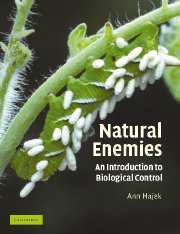Book contents
- Frontmatter
- Contents
- Preface
- Acknowledgments
- Introduction
- PART I Strategies for using natural enemies
- Chapter 3 Classical biological control
- Chapter 4 Augmentation: inundative and inoculative biological control
- Chapter 5 Conservation and enhancement of natural enemies
- PART II Biological control of invertebrate and vertebrate pests
- PART III Biological control of weeds
- PART IV Biological control of plant pathogens and plant parasitic nematodes
- PART V Biological control: concerns, changes, and challenges
- Glossary
- References
- Index
Chapter 4 - Augmentation: inundative and inoculative biological control
Published online by Cambridge University Press: 05 June 2012
- Frontmatter
- Contents
- Preface
- Acknowledgments
- Introduction
- PART I Strategies for using natural enemies
- Chapter 3 Classical biological control
- Chapter 4 Augmentation: inundative and inoculative biological control
- Chapter 5 Conservation and enhancement of natural enemies
- PART II Biological control of invertebrate and vertebrate pests
- PART III Biological control of weeds
- PART IV Biological control of plant pathogens and plant parasitic nematodes
- PART V Biological control: concerns, changes, and challenges
- Glossary
- References
- Index
Summary
The second and third major ways to use biological control, inoculative and inundative biological control, both involve releasing biological control agents without the goal of permanent establishment. Although these two strategies have different goals and ways in which they work, there are strong commonalities and thus they are usually jointly referred to as augmentation. These strategies are used to control pests when natural enemies are absent, when the control due to natural enemies would naturally occur too late to prevent damage, or when natural enemies occur naturally in numbers too low to provide effective control. The term augmentation is used because natural enemies are being augmented, even when they already occur in the release area but are not abundant enough to provide control.
Inundative biological control
The use of living organisms to control pests when control is achieved exclusively by the organisms themselves that have been released
(Eilenberg et al., 2001)This strategy is directed toward rapid control of pests over the short term. In all cases, no reproduction by the natural enemy is expected. Because control is only due to the released individuals, inundative releases would have to be repeated if pest populations increase again after natural enemies are released. In practice, releases are often repeated if pest populations were not all present in a susceptible stage during the previous application, if new pests disperse into the crop, or if the crop is long lived, increasing the length of time it could become infested.
Information
- Type
- Chapter
- Information
- Natural EnemiesAn Introduction to Biological Control, pp. 62 - 79Publisher: Cambridge University PressPrint publication year: 2004
Accessibility standard: Unknown
Why this information is here
This section outlines the accessibility features of this content - including support for screen readers, full keyboard navigation and high-contrast display options. This may not be relevant for you.Accessibility Information
- 2
- Cited by
